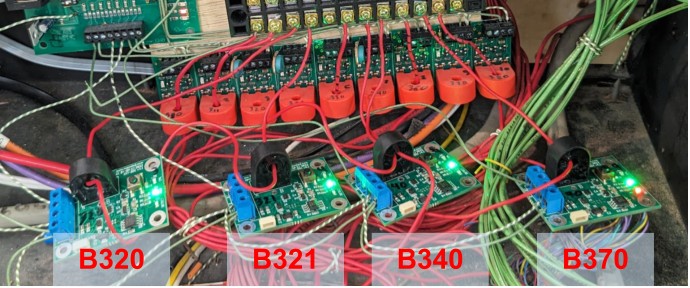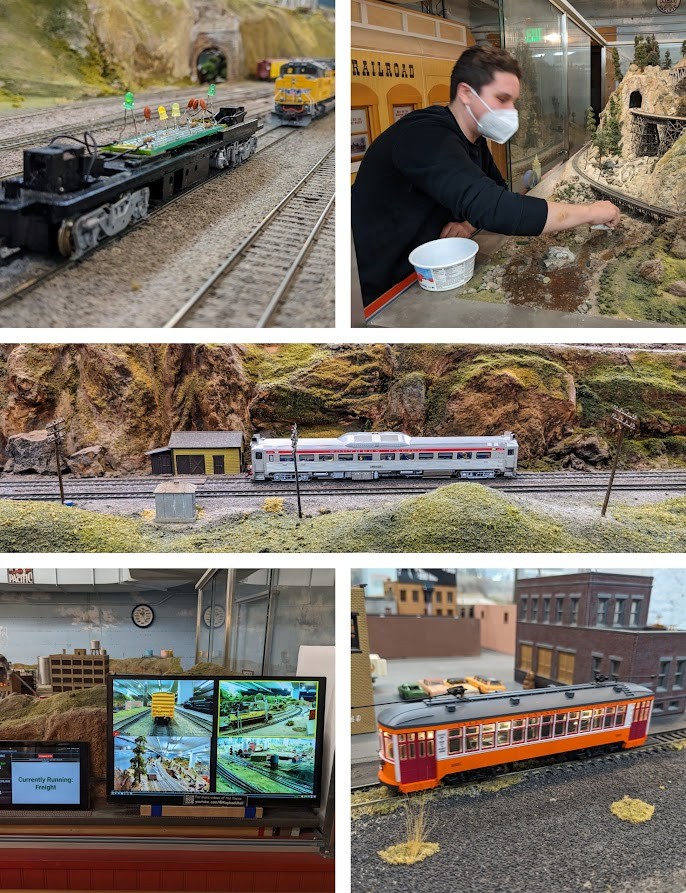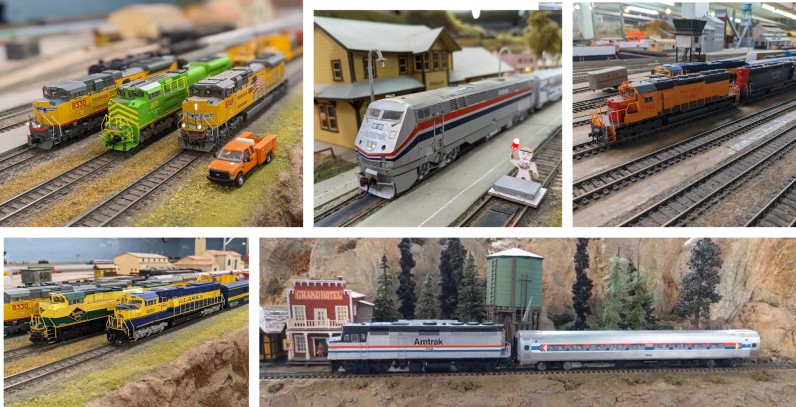The Randall Museum in San Francisco hosts a large HO-scale model railroad. Created by the Golden Gate Model Railroad Club starting in 1961, the layout was donated to the Museum in 2015. Since then I have started automatizing trains running on the layout. I am also the model railroad maintainer. This blog describes various updates on the Randall Museum Model Railroad and I maintain a separate tech blog for all my electronics & software not directly related to Randall.
2024-04-24 - Fairfield Scenery
Category RandallOrion just completed this scenery project in Fairfield:
This used to be -- and is still -- an access hatch. I cut a piece of plywood a while ago of the right size, and Orion designed and added scenery to be easy to lift and move away as needed. He made the hill out of paper with a cloth surface, then painted, with grass and details glued in place.
This being California, we can see the clear fault lines around the park. That makes it easier to remove the access hatch.
Click here to continue reading...
The trolley automation regularly stops on this turnout:
This is definitely one of these Atlas turnouts where the frog is isolated. One way to handle these is to power the frog by placing a little screw and then soldering to it -- the metal of the frog is such that solder won’t stick to it easily as far as I know. There’s a little hole next to the frog that makes contact with the frog. I didn’t have a screw that would fit that, but I had some electrical wire of the adequate size. Also right now, we’re not going to run through the thrown leg of that turnout, so…
Click here to continue reading...
After noticing that one of the NCE boosters had a different output voltage, I double checked the setup. We do indeed use NCE PB5 boosters, and their power brick has a switch for 12 V (N scale) or 13.8 V (HO scale). One of them was incorrectly set on 12 V.
That was enough to fix the voltage issue on the track:
Click here to continue reading...
With Allen, we used the new “voltmeter car” to measure the DCC voltage on the track at different spots. As expected, the voltage varies by booster somewhat, and then I got an interesting surprise.
Booster 1 |
13.1 V |
P1 V1 (Valley1), P1 STKYD |
Booster 2 |
10.8 V |
P2 V2 (Valley2), P2 NAPA, P2 TOWN LODI, P2 FAIRFIELD |
Booster 3 |
12.5 V |
P3 MTN-1, P3 BRN RCH-2 |
Booster 4 |
12.6 V |
P4 MTN-2, P4 BRPORT, P4 SIA RND, P4 STK STN |
Booster 1 |
Booster 2 |
Booster 3 |
Booster 4 |
Click here to continue reading...
The trolley automation has been running (more or less) since I made this video back in November 2023:
The software part of the automation with the SDB on the ESP32 and the link with JMRI and RTAC works fairly well. The problems that arise are fairly mechanical. The Bowser streetcar is quite finicky and often does not stop running.
The trolley automation also regularly fails because the trolley gets stuck on the one turnout in that little spur where it is running back and forth:
That looks like one of these old Atlas turnouts where the turnout frog is not powered. We have a few of these around, especially in the yards. This is the assumption. It needs to be verified by checking the power routing on that turnout.
Assuming it’s that case, what are the possible solutions?
Click here to continue reading...
I have had reports from Saturday Operators of trains slowing up and down when leaving the yard, not maintaining constant speed. I’ve personally seen that too when trying the newly fixed UP Walthers engine a few days before. Then a few minutes later, everything was acting normally in both cases.
One possibility would be dirty track. The pads of the track cleaning train are filthy and haven’t been changed in a while. However that would not explain why the issue goes away after a short time.
The other possibility is an electrical issue. What we need is a way to measure the track voltage and see if it changes. I don’t have a RRampMeter at hand for the task, yet we can easily replicate that using scrap components I have around already.
Thus, I made a “voltmeter car” to display the track voltage:
What you’re looking at in the picture above is a donor chassis from an old DC engine, and a few components I had at home: a “full” bridge rectifier (I removed the smoothing capacitor) connected to the track power pickups, and on top a basic voltmeter display. The idea is to measure the peak of the DCC signals as if it were a DC one, which should be more accurate than a multimeter in AC mode (we’re not doing AC Vrms here).
Click here to continue reading...
The little saga with the new Walthers Mainline SD70ACe continues for UP 8312.
Back in January, I got the replacement motors sent by the Walthers’ customer support representative. I finally got around to replacing the motor in 8312. The design of the Walthers engine is not too bad in that regard except that I noticed a few of the wires easily get stuck between the circuit board and the plastic shell, which tends to break their insulation. Thus one would have to be very careful when opening/closing that engine repeatedly.
Click here to continue reading...
Last year, I was having problems with some of the track occupancy block sensors on the mainline automation. Turns out that the new UP Walthers engines use a lot less power than the previous engines, and the NCE BD20 were having difficulties detecting the presence of the trains.
Instead, I finally finished replacing the problematic sensors by newer Iowa Scaled CKT-BD1 sensors:
Only blocks B320, B321, B340 + B350, and B370 have the new sensors.
This is located behind the Mountain 1 Block Panel. Quite frankly, it’s a bit of a mess and that install needs an organization overhaul at some point:
Click here to continue reading...
It’s time for the regular Freight train to go back to the automation and replace the Polar Express.
The trolley automation is starting to work as promised:
The ESP32 software now communicates with JMRI using MQTT, which gives better response times (down from 1050 ms to 2-6 ms!)
I’ll leave this running as is for a couple more weeks to see if I got all the issues figured out. I may want to slightly adjust the timing of the trolley, for example.
The next step after is to finalize the sensor installation: first I’ll change the ESP32 for one without the OLED display (the display is very useful for debugging, but useless after since nobody will be looking at it), then I need to add a couple LEDs to display an ok/failure status (since there won’t be any screen anymore), and finally the goal is to mount the sensor next to the track, probably hidden by a building, while the ESP32 should be mounted below the layout. See, just a few loose ends to finish… the usual 90/90 rule of software engineering.
2024-01-01 - Happy New Year
Category RandallHappy New Year 2024 from the Randall Museum Model Railroad team.















